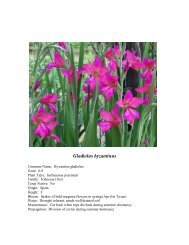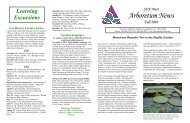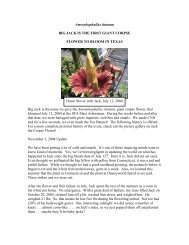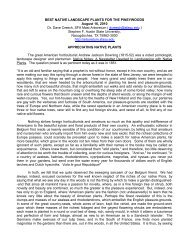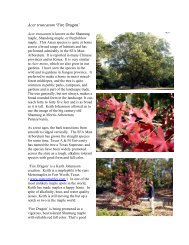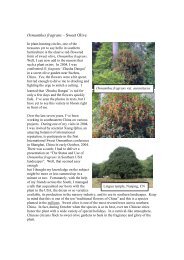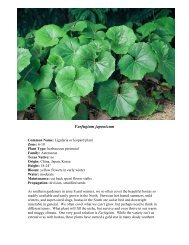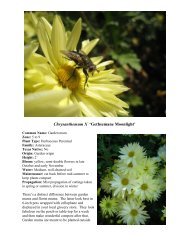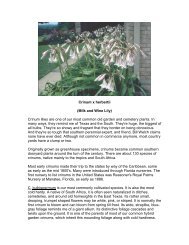TAXODIUM The following is lifted from the MSc ... - SFA Gardens
TAXODIUM The following is lifted from the MSc ... - SFA Gardens
TAXODIUM The following is lifted from the MSc ... - SFA Gardens
Create successful ePaper yourself
Turn your PDF publications into a flip-book with our unique Google optimized e-Paper software.
peizhongii, implying that T. peizhongii <strong>is</strong> not an intergeneric hybrid between <strong>the</strong> two species”<br />
(Ling Y et al. 2006).<br />
Salt Tolerance<br />
Many coastal wetlands of <strong>the</strong> sou<strong>the</strong>astern United States are threatened by<br />
increases in flooding and salinity as a result of both natural processes and man-<br />
induced hydrologic alterations (Allen 1992; Conner and Toliver 1990; Craig et<br />
al.1979; Templet and Meyer-Arendt 1988; Wicker et al. 1981). If predicted<br />
climate changes occur, <strong>the</strong> consequent r<strong>is</strong>e in sea level will cause flooding and<br />
salt water intrusion in many coastal areas (Daniels 1992; Kerr 1991; Smith and<br />
Tirpak 1989; Titus 1988; Wigley and Raper 1993). Salt-tolerant trees can<br />
withstand concentrations up to 40,000 parts per million (ppm) of salt water.<br />
Wahome et al. (2001) define salt tolerance as “<strong>the</strong> ability of a plant to maintain<br />
growth and metabol<strong>is</strong>m under saline conditions”.<br />
Salt can damage trees in two ways. Salt in <strong>the</strong> soil can adversely affect soil<br />
structure and damage a tree’s roots, causing <strong>the</strong> crown to thin; however, aerial<br />
deposition of salt on <strong>the</strong> above-ground parts of a plant causes <strong>the</strong> most damage<br />
and ocean spray <strong>is</strong> <strong>the</strong> primary culprit. <strong>The</strong> average concentration of <strong>the</strong> ocean<br />
water <strong>is</strong> as high as 34.9 parts per thousand (ppt). During extreme conditions,<br />
such as hurricanes, salt spray can affect plants as far as 50 miles inland,<br />
although most damage occurs within 1,000 feet of <strong>the</strong> shore. Salt damage may<br />
take various forms: delayed bud break, reduced leaf size, desiccated leaf<br />
margins and tips, premature fall coloration and leaf fall, bud and stem dieback,<br />
and reduced shoot growth. Salt produces <strong>the</strong>se symptoms by altering osmotic<br />
pressure and, where soil <strong>is</strong> salty, upsetting <strong>the</strong> mineral nutritional balance.



